| Article ID | Journal | Published Year | Pages | File Type |
|---|---|---|---|---|
| 8041192 | Nuclear Instruments and Methods in Physics Research Section B: Beam Interactions with Materials and Atoms | 2014 | 6 Pages |
Abstract
Helium-containing titanium films synthesized by magnetron sputtering method were investigated using thermal desorption spectrometry (TDS), transmission electron microscopy (TEM), and scanning electron microscopy (SEM). Helium evolution behaviors under thermal treatment from room temperature to 1500 °C were characterized. Four peaks appeared in TDS at around 100, 420, 700, and 1250 °C were identified and attributed to helium desorption from the specimen surface, substitutional helium (helium atom in a vacancy), small HemVn clusters with different helium-to-vacancy ratios, and helium bubbles or voids, respectively. The helium evolution under thermal treatment composed of two coexisting and competing processes, where the faster process dominated in relevant temperature range, i.e. helium diffusion and release at low temperatures, and bubble or void formation at high temperatures. Three characteristic temperatures in TDS were identified in description of the phenomenon.
Related Topics
Physical Sciences and Engineering
Materials Science
Surfaces, Coatings and Films
Authors
Jinchao Zhang, Chun Cheng, Erdong Wu, Liangyin Xiong, Shi Liu,
